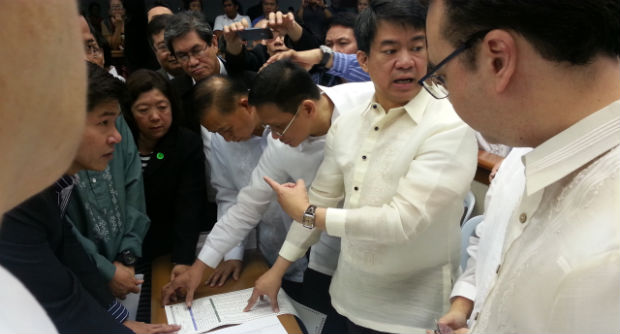Brillantes defends Comelec vs discrepancies in Senatorial poll count

Senator Aquilino “Koko” Pimentel III examines some of the ballots from General Tinio, Nueva Ecija that allegedly had discrepancies between the physical ballot and the digital image recorded on the PCOS. Commission on Elections (Comelec) Chairman Sixto Brillantes Jr. faced the Senate Thursday, Sept. 19, 2014, to explain these discrepancies. MATIKAS SANTOS/INQUIRER.net
MANILA, Philippines — The Commission on Elections (Comelec) defended itself in the Senate over alleged cases of discrepancies in several precincts during the 2013 Senatorial Elections.
One alleged case involved the discrepancy between the count of physical ballots and the Precinct Count Optical Scan (PCOS) machines in Precinct 19 of the municipality of General Tinio, Nueva Ecija could turn out to be a case of post-election tampering, Commission on Elections (Comelec) Chairman Sixto Brillantes Jr. said during the Joint Congressional Oversight Committee (JCOC) hearing.
Bangon Pilipinas Party of Eddie Villanueva had previously filed a petition before the Regional Trial Court asking for a recount of the ballots, alleging that the PCOS machine count was wrong.
The ballots of Precinct number 19 were then opened in court and were manually counted.
But Brillantes said that the RTC judge opened the ballot box even though it wasn’t under his jurisdiction and did not follow Comelec Guidelines.
Article continues after this advertisementBrillantes noted that the alleged discrepancies were found only on the physical ballots but not on the digital images of the ballots.
Article continues after this advertisement“[This was a case of] post-election tampering and manipulation of the ballot box. When they were opened there was already a shade for Villanueva,” Brillantes said.
“[The shade] was placed by somebody else [other than the voter]. Marking shade does not appear to be a done using a Comelec pen. There is also an obvious difference with all the other shades on the ballot,” he said.
Brillantes also noted that the ballots were neither substituted nor faked.
He said they would order the immediate investigation of the tampering case in Nueva Ecija.
Glenn Chiong, legal consultant for the petitioners in the General Tinio case, also brought up a case of discrepancies in Precint 193,
Barangay Talima, Lapu-lapu City, Cebu where the PCOS machines counted more votes of senatorial candidates than the shaded ovals.
Brillantes admitted this happened in several precincts because of a “glitch” where “digital lines” would appear on the digital image of the ballot causing ovals of candidates to be filled.
In the Barangay Talima case, one voter shaded only four ovals of candidates, but because of a “digital line” running along the digital image of the ballot, eight other candidates were counted by the PCOS machine.
“We saw this already in 2013, it will not adversely affect the result of any election,” Brillantes said.
Marlon Garcia, the technology manager of Smartmatic Asia Pacific which provided the PCOS machines, explained that the “digital lines” were caused by an ink stain in the scanning device of the machine.
“[We found] there was a stain on the [scanning portion] which matched the position of the ovals. If the ballot has too much ink [from shading], it will cause a stain,” Garcia said.
Brillantes said that to ensure there would no longer be the issue of “digital lines” in the upcoming 2016 presidential elections, they would impose stricter ink quality testing and also procure a possible replacement with less likelihood of staining.
RELATED STORIES
Brillantes: Discrepancies in count unavoidable
More join call for poll probe